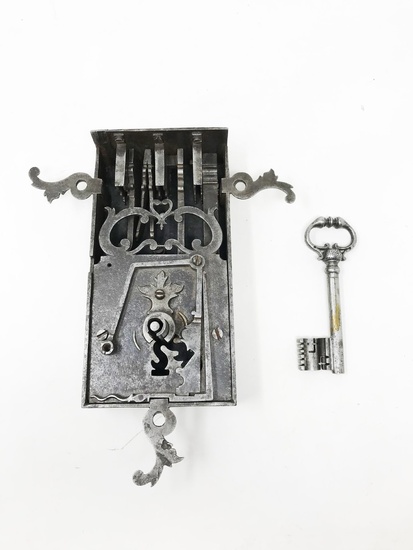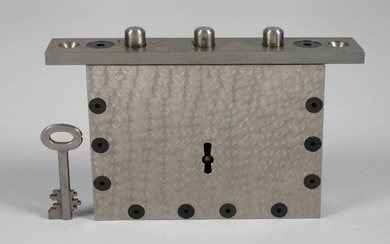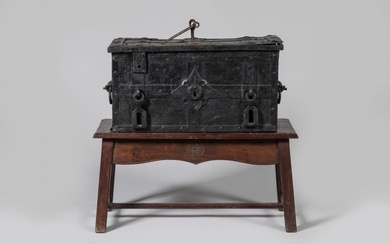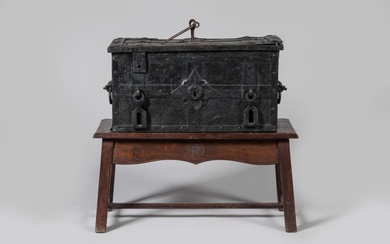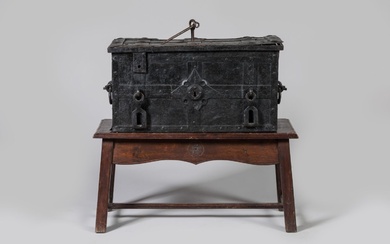Serrure. 10, 2 x 20, 4 cm et sa clé 12, 62... - Lot 70 - Art Richelieu
Serrure. 10, 2 x 20, 4 cm et sa clé 12, 62 cm. Décrites page 194, planche 26 dans L’art du serrurier par Duhamel Dumonceau en 1767, les serrures de maîtrise imposent un secret pour ouvrir mais celle-ci comporte quatre complications de plus. A droite de l’entrée normale, une seconde entrée de clé décalée d’un huitième de tour est partiellement obstruée par un levier à ressort dont le bouton est à gauche de l’entrée de clé. Un tour de clé à droite suivi d’un quart de tour à droite ouvre le pêne central et la gâchette de gauche. Pour libérer la gâchette de droite, on tourne la clé d’un huitième de tour à gauche. Son panneton est alors aligné avec la deuxième entrée de clé qui est en fait une sortie. On tire alors la clé vers soi, la sortant partiellement. Mais pour le faire, il faut pousser le bouton du levier vers la droite pour libérer la sortie de clé de son obstruction. Il faut donc deux mains pour finir l’ouverture : (1), la main gauche déplace l’obturateur de sortie de clé pendant que (2), la main droite tire sur la clé et (3), la maintenant semi extraite (4), elle tourne la clé d’un huitième de tour à gauche et qu’enfin la main gauche soulève le couvercle abattant du coffre. Alors que les gâchettes de ces serrures oscillent latéralement pour s’ouvrir, la gâchette de droite de cette serrure oscille perpendiculairement d’arrière en avant. Planche 26- L’art du serrurier 1767. Rare quadruple secret Master Piece lock as described by Duhamel Dumonceau page 194 and plate 26 in L’art du serrurier in 1767. Master piece locks of that time often had one dead bolt flanked by two spring loaded latches retaining a 3 ring striking plate and a secret sequence to open. Most frequently it required a full turn of the key clockwise followed by a quarter turn clockwise and a quarter turn anticlockwise. But this lock requires four more secret movements to open. Its front plate has a second key way offset by one eighth of a turn to the right of the normal one and partially obstructed by a spring-loaded plate controlled by the knob of a bell crank lever to the left of the key way. Turning the key one and one quarter of a turn clockwise opens the central dead bolt and the spring loaded latch to its left. To open the last latch, the key is turned one eighth of a turn anticlockwise. The key bit is then aligned with the second key entrance which is in fact an exit. The key needs to be partially pulled out to open the last latch. But to do that the obstructing plate has to be moved away by pushing the knob of the bell crank lever to the right. At that stage, two hands are needed to open the lock. The left hand pushes the knob to the right to allow the right hand to pull and hold the key partially out. Then only, the left hand can lift and open the lid of the safe. While the latches in these locks oscillate laterally, like the left one does, the right latch oscillates axially from back to front. Beschrieben auf Seite 194 , Brett 26 in Die Kunst des Schlossers von Duhamel Dumonceau im Jahr 1767, die Master-Schlösser legen ein Geheimnis zum Öffnen, aber dieses beinhaltet vier weitere Komplikationen. Rechts vom normalen Eingang wird ein zweiter Schlüsseleintrag, der um eine Achteldrehung verschoben ist, teilweise von einem Federhebel blockiert, dessen Knopf links vom Schlüsseleingang ist. Eine Schlüsselrunde rechts, gefolgt von einer Vierteldrehung rechts, öffnet den mittleren Pfennen und den linken Abzug. Um den Rechten abzugsfrei zu machen, drehen wir den Schlüssel zu einem Achtel nach links. Sein Panneton wird dann mit dem zweiten Schlüsseleingang ausgerichtet, der eigentlich ein Ausgang ist. Dann zieht man den Schlüssel zu sich selbst, zieht ihn teilweise heraus. Aber um dies zu tun, muss man den Knopf des Hebels nach rechts drücken, um den Schlüsselausgang von seiner Behinderung zu befreien. Man braucht also zwei Hände, um die Öffnung zu beenden: 1 die linke Hand verschiebt den Schlüsselaustrittsverschluss, während 2 die rechte Hand auf den Schlüssel zieht und 3 die jetzt halb herausgezwirnte 4 den Schlüssel eines Achteldrehs nach links dreht und die linke Hand schließlich den abreißenden Deckel aus dem Kofferraum hebt. Während die Ventile dieser Schlösser seitlich schwingen, um sich zu öffnen, schwingt der rechte Abzug dieses Schlosses senkrecht von hinten nach vorn
[ translate ]Estimate
Time, Location
Auction House
Serrure. 10, 2 x 20, 4 cm et sa clé 12, 62 cm. Décrites page 194, planche 26 dans L’art du serrurier par Duhamel Dumonceau en 1767, les serrures de maîtrise imposent un secret pour ouvrir mais celle-ci comporte quatre complications de plus. A droite de l’entrée normale, une seconde entrée de clé décalée d’un huitième de tour est partiellement obstruée par un levier à ressort dont le bouton est à gauche de l’entrée de clé. Un tour de clé à droite suivi d’un quart de tour à droite ouvre le pêne central et la gâchette de gauche. Pour libérer la gâchette de droite, on tourne la clé d’un huitième de tour à gauche. Son panneton est alors aligné avec la deuxième entrée de clé qui est en fait une sortie. On tire alors la clé vers soi, la sortant partiellement. Mais pour le faire, il faut pousser le bouton du levier vers la droite pour libérer la sortie de clé de son obstruction. Il faut donc deux mains pour finir l’ouverture : (1), la main gauche déplace l’obturateur de sortie de clé pendant que (2), la main droite tire sur la clé et (3), la maintenant semi extraite (4), elle tourne la clé d’un huitième de tour à gauche et qu’enfin la main gauche soulève le couvercle abattant du coffre. Alors que les gâchettes de ces serrures oscillent latéralement pour s’ouvrir, la gâchette de droite de cette serrure oscille perpendiculairement d’arrière en avant. Planche 26- L’art du serrurier 1767. Rare quadruple secret Master Piece lock as described by Duhamel Dumonceau page 194 and plate 26 in L’art du serrurier in 1767. Master piece locks of that time often had one dead bolt flanked by two spring loaded latches retaining a 3 ring striking plate and a secret sequence to open. Most frequently it required a full turn of the key clockwise followed by a quarter turn clockwise and a quarter turn anticlockwise. But this lock requires four more secret movements to open. Its front plate has a second key way offset by one eighth of a turn to the right of the normal one and partially obstructed by a spring-loaded plate controlled by the knob of a bell crank lever to the left of the key way. Turning the key one and one quarter of a turn clockwise opens the central dead bolt and the spring loaded latch to its left. To open the last latch, the key is turned one eighth of a turn anticlockwise. The key bit is then aligned with the second key entrance which is in fact an exit. The key needs to be partially pulled out to open the last latch. But to do that the obstructing plate has to be moved away by pushing the knob of the bell crank lever to the right. At that stage, two hands are needed to open the lock. The left hand pushes the knob to the right to allow the right hand to pull and hold the key partially out. Then only, the left hand can lift and open the lid of the safe. While the latches in these locks oscillate laterally, like the left one does, the right latch oscillates axially from back to front. Beschrieben auf Seite 194 , Brett 26 in Die Kunst des Schlossers von Duhamel Dumonceau im Jahr 1767, die Master-Schlösser legen ein Geheimnis zum Öffnen, aber dieses beinhaltet vier weitere Komplikationen. Rechts vom normalen Eingang wird ein zweiter Schlüsseleintrag, der um eine Achteldrehung verschoben ist, teilweise von einem Federhebel blockiert, dessen Knopf links vom Schlüsseleingang ist. Eine Schlüsselrunde rechts, gefolgt von einer Vierteldrehung rechts, öffnet den mittleren Pfennen und den linken Abzug. Um den Rechten abzugsfrei zu machen, drehen wir den Schlüssel zu einem Achtel nach links. Sein Panneton wird dann mit dem zweiten Schlüsseleingang ausgerichtet, der eigentlich ein Ausgang ist. Dann zieht man den Schlüssel zu sich selbst, zieht ihn teilweise heraus. Aber um dies zu tun, muss man den Knopf des Hebels nach rechts drücken, um den Schlüsselausgang von seiner Behinderung zu befreien. Man braucht also zwei Hände, um die Öffnung zu beenden: 1 die linke Hand verschiebt den Schlüsselaustrittsverschluss, während 2 die rechte Hand auf den Schlüssel zieht und 3 die jetzt halb herausgezwirnte 4 den Schlüssel eines Achteldrehs nach links dreht und die linke Hand schließlich den abreißenden Deckel aus dem Kofferraum hebt. Während die Ventile dieser Schlösser seitlich schwingen, um sich zu öffnen, schwingt der rechte Abzug dieses Schlosses senkrecht von hinten nach vorn
[ translate ]